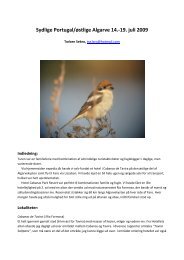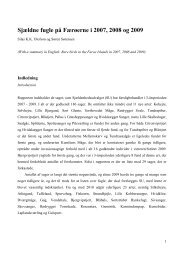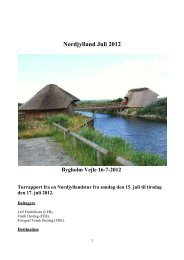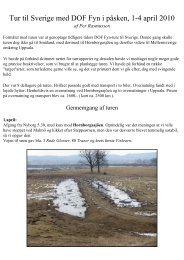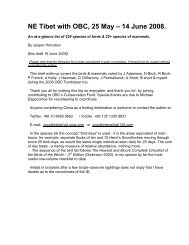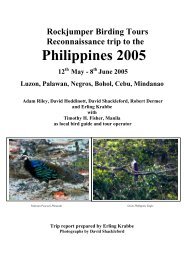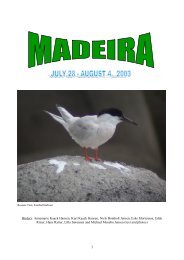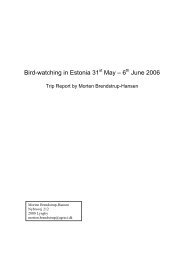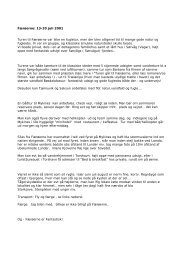TURKEY - a report from a birdwatching trip to Central ... - Netfugl.dk
TURKEY - a report from a birdwatching trip to Central ... - Netfugl.dk
TURKEY - a report from a birdwatching trip to Central ... - Netfugl.dk
You also want an ePaper? Increase the reach of your titles
YUMPU automatically turns print PDFs into web optimized ePapers that Google loves.
2007: Most 14.5 6 Akgöl, Göksu Delta – 16.5 17 Sultan Sazligi – 18.5 12 Erzinzan-Altunkent –<br />
19.5 8 Ardahan -20.5 6 Saz Gölü – 21.5 6 Bulanik – 22.5 4 Idil.<br />
19. Purple Heron Ardea purpurea Purpurhejre<br />
More common than Grey Heron, with frequent observations in extensive wetlands, especially with<br />
large reed beds.<br />
2005: Most 14.5 10 Akgöl, Göksu Delta.<br />
2006: Most 14.5 11 Akgöl, Göksu Delta – 17.5 10 Sultan Sazligi. Only single<strong>to</strong>ns in the east, apart<br />
<strong>from</strong> 22-23.5 daily max. 3 South Van Marshes, Van.<br />
2007: Most 14.5 45 Akgöl, Göksu Delta – 16.5 11 Sultan Sazligi – 16.5 8 Ovaciftlik – 20.5 4 Saz<br />
Gölü – 21.5 4 Caldiran Marshes.<br />
2-5000 pairs breeds in Turkey. Breeds in freshwater lakes with extensive reed beeds.<br />
The general "anorectic" shape of the species and the general darkness was most striking at distance<br />
- especially the spike-like bill, the extremely slender body and deep "throat patch", which somewhat<br />
reminded us of the gular parts of Marabou S<strong>to</strong>rk in flight were eye catching. The spread <strong>to</strong>es, often<br />
cited as a good character, were observed on a couple of occasions (but usually after the legs have<br />
proven <strong>to</strong> be yellow) - it was however rarely a main suspicion character.<br />
20. White S<strong>to</strong>rk Ciconia ciconia Hvid S<strong>to</strong>rk<br />
Rather common in agricultural landscape, with nests noted locally in small colonies.<br />
2005: Most at Göksu Delta: 15 on 15.5 and 20 on 24.5, on pylons between Nigde and Sultan<br />
Marshes, and on almost any pylon between Batman and Diyarbakir 21.5. 22.5 a flock of 32<br />
migrating north Birezik.<br />
2006: Widespread, but rather local. Most 15.5 20 Karaman-Eregli.<br />
2007: Widespread, most 14.5 16 Akgöl, Göksu Delta – 15.5 26 Göksu Delta (incl. several nesting)<br />
– 20.5 6 Saz Gölü – 21.5 10 Bulanik – 22.5 40 Baykan-Batman.<br />
Breeds scattered throughout the country and seen with nests several sites, often in loose colonies.<br />
Total Turkish breeding population 15.000-35.000 pairs (Tucker & Heath 1994).<br />
Massive migration pass Turkey spring and autumn. In autumn 1972, 339.000 counted Bosphorus<br />
(Cramp & Simmons 1977)), heading for the Levant via south Mediterranean coast, with massive<br />
migration around Adana (Toprakalle, Belen pass) - the same route used by rap<strong>to</strong>rs. Further <strong>to</strong> the<br />
south, max. 300.000 (maybe up <strong>to</strong> 500.000) may pass per autumn at Israeli count sites, peaking late<br />
Aug-early Sept. with day count up <strong>to</strong> 70.000. Spring counts much the same, with peak late March. It<br />
should be possible <strong>to</strong> observe this massive migration in the Adana area.<br />
21. Black S<strong>to</strong>rk Ciconia nigra Sort S<strong>to</strong>rk<br />
2005: 17.5 1 2 cal year migrating Hopa.<br />
2006: 17.5 8 Sultan Sazligi - 19.5 1 2nd cal. year migrating Kalkandere.<br />
2007: 16.5 6 (of which 3 2 nd cal. year) Sultan Sazligi – 17.5 4 Cöl Cölu – 19.5 1 migrating Hopa.<br />
Turkey forms the southwesternmost breeding range.500-2000 pairs breeds in Turkey, especially in<br />
C and N parts. Prefers large moist, mixed forest near water, such as rivers and streams




